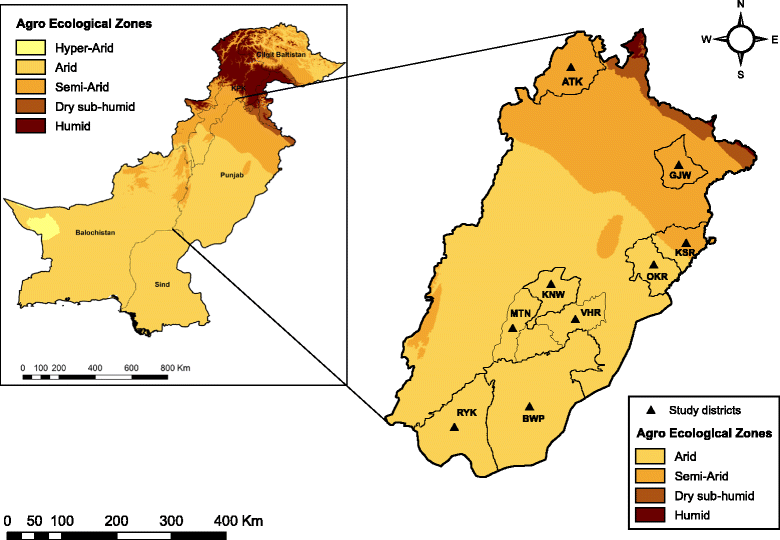Distribution of ticks infesting ruminants and risk factors associated with high tick prevalence in livestock farms in the semi-arid and arid agro-ecological zones of Pakistan
- PMID: 28420420
- PMCID: PMC5395890
- DOI: 10.1186/s13071-017-2138-0
Distribution of ticks infesting ruminants and risk factors associated with high tick prevalence in livestock farms in the semi-arid and arid agro-ecological zones of Pakistan
Abstract
Background: Tick infestation is the major problem for animal health that causes substantial economic losses, particularly in tropical and subtropical countries. To better understand the spatial distribution of tick species and risk factors associated with tick prevalence in livestock in Pakistan, ticks were counted and collected from 471 animals, including 179 cattle, 194 buffaloes, 80 goats and 18 sheep, on 108 livestock farms in nine districts, covering both semi-arid and arid agro-ecological zones.
Results: In total, 3,807 ticks representing four species were collected: Hyalomma anatolicum (n = 3,021), Rhipicephalus microplus (n = 715), Hyalomma dromedarii (n = 41) and Rhipicephalus turanicus (n = 30). The latter species is reported for the first time from the study area. Rhipicephalus microplus was the predominant species in the semi-arid zone, whereas H. anatolicum was the most abundant species in the arid zone. The overall proportion of tick-infested ruminants was 78.3% (369/471). It was highest in cattle (89.9%), followed by buffaloes (81.4%), goats (60.0%) and sheep (11.1%). The median tick burden significantly differed among animal species and was highest in cattle (median 58), followed by buffaloes (median 38), goats (median 19) and sheep (median 4.5). Female animals had significantly higher tick burdens than males and, in large ruminants, older animals carried more ticks than younger animals. The intensity of infestation was significantly lower in indigenous animals compared to exotic and crossbred cows. Analysis of questionnaire data revealed that the absence of rural poultry, not using any acaricides, traditional rural housing systems and grazing were potential risk factors associated with a higher tick prevalence in livestock farms.
Conclusion: Absence of rural poultry, not performing acaricide treatments, traditional rural housing systems and grazing were important risk factors associated with higher tick prevalence in livestock farms. Age, gender, breed and animal species significantly affected the intensity of tick infestation. This report also describes the presence of R. turanicus in the Punjab Province of Pakistan for the first time. The outcomes of this study will be useful in the planning of integrated control strategies for ticks and tick-borne diseases in Pakistan.
Keywords: Pakistan; Prevalence; Risk factors; Ruminants; Ticks.
Figures



Similar articles
-
Epidemiology, Distribution and Identification of Ticks on Livestock in Pakistan.Int J Environ Res Public Health. 2022 Mar 4;19(5):3024. doi: 10.3390/ijerph19053024. Int J Environ Res Public Health. 2022. PMID: 35270717 Free PMC article.
-
Exploring the prevalence and diversity of bovine ticks in five agro-ecological zones of Pakistan using phenetic and genetic tools.Ticks Tick Borne Dis. 2020 Sep;11(5):101472. doi: 10.1016/j.ttbdis.2020.101472. Epub 2020 May 22. Ticks Tick Borne Dis. 2020. PMID: 32723634
-
Identification and prevalence of ticks infesting small ruminants of Fort Munro region in South Punjab, Pakistan.Vet Parasitol Reg Stud Reports. 2024 Aug;53:101069. doi: 10.1016/j.vprsr.2024.101069. Epub 2024 Jun 18. Vet Parasitol Reg Stud Reports. 2024. PMID: 39025548
-
Distribution and ecology of ticks (Acari: Ixodidae) infesting livestock in Tunisia: an overview of eighth years field collections.Parassitologia. 1999 Sep;41 Suppl 1:5-10. Parassitologia. 1999. PMID: 11071534 Review.
-
Geographical epidemiology of Hyalomma anatolicum and Rhipicephalus microplus in Pakistan: A systematic review.PLoS One. 2024 Aug 23;19(8):e0309442. doi: 10.1371/journal.pone.0309442. eCollection 2024. PLoS One. 2024. PMID: 39178282 Free PMC article.
Cited by
-
Molecular detection of Coxiella burnetii in ticks infesting wild and domestic animals in the Eastern region of Punjab, Pakistan.Trop Anim Health Prod. 2024 Sep 3;56(7):252. doi: 10.1007/s11250-024-04087-8. Trop Anim Health Prod. 2024. PMID: 39225870
-
Impact of Farm Management Practices on Tick Infestation in Punjab's Livestock: A Comprehensive Epidemiological Study.Animals (Basel). 2024 Aug 22;14(16):2437. doi: 10.3390/ani14162437. Animals (Basel). 2024. PMID: 39199969 Free PMC article.
-
Genetic diversity, piroplasms and trypanosomes in Rhipicephalus microplus and Hyalomma anatolicum collected from cattle in northern Pakistan.Exp Appl Acarol. 2019 Oct;79(2):233-243. doi: 10.1007/s10493-019-00418-9. Epub 2019 Oct 1. Exp Appl Acarol. 2019. PMID: 31578647
-
Identification of Intestinal Fungal Microflora and Bacterial Pathogens in the Collected Adult Ixodes ricinus from the Northern Provinces of Iran.J Arthropod Borne Dis. 2022 Jun 30;16(2):97-107. doi: 10.18502/jad.v16i2.11801. eCollection 2022 Jun. J Arthropod Borne Dis. 2022. PMID: 37038504 Free PMC article.
-
Epidemiology, Distribution and Identification of Ticks on Livestock in Pakistan.Int J Environ Res Public Health. 2022 Mar 4;19(5):3024. doi: 10.3390/ijerph19053024. Int J Environ Res Public Health. 2022. PMID: 35270717 Free PMC article.
References
-
- Mather TN, Abdullah GA. Building molecular biology capacity for preventing tick-transmitted diseases in Pakistan. Pakistan-Us Science and Technology Cooperation Program. http://sites.nationalacademies.org/PGA/dsc/pakistan/PGA_052866. Accessed 23 Nov 2015.
-
- LDDDP . Punjab Livestock Policy paper. Lahore: LDDDP; 2015. pp. 8–21.
-
- Khan A. The characterization of the agro-ecological context in which FAnGR (farm animal genetic resource) are found. Nairobi: ILRI; 2004. pp. 1–104.
MeSH terms
LinkOut - more resources
Full Text Sources
Other Literature Sources

